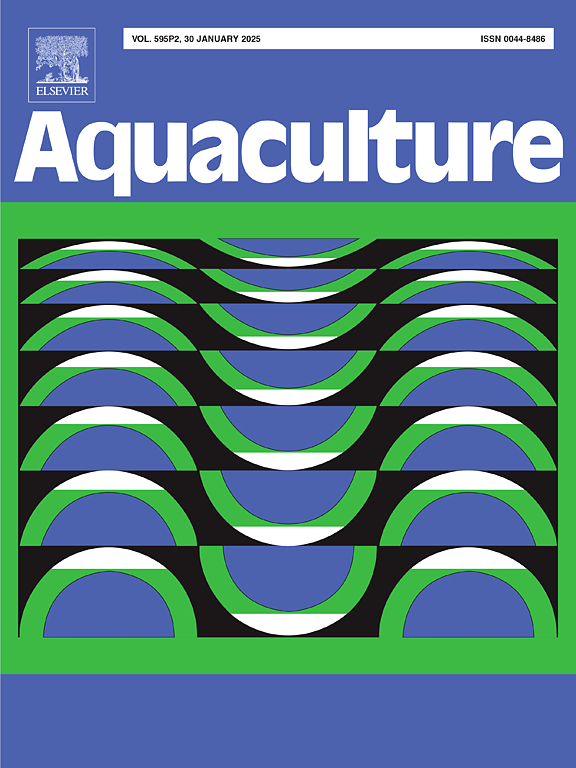增强的t细胞激活和效应功能有助于无乳链球菌抗性罗非鱼的疾病抗性
IF 3.9
1区 农林科学
Q1 FISHERIES
引用次数: 0
摘要
为了解决罗非鱼养殖中频繁出现的无乳链球菌感染所带来的巨大挑战,我们以前开发了一种对这种病原体具有增强抵抗力的罗非鱼菌株。了解这种抗性背后的免疫机制对于推进选择性育种策略至关重要。本研究主要从t细胞活化和效应功能方面探讨耐S.无乳乳酸罗非鱼免疫能力增强的原因。通过RNA-seq和免疫学分析,我们证明了抗性罗非鱼比易感罗非鱼具有更高比例的T细胞和增强的T细胞效应功能。体外抗罗非鱼CD3ε + CD28单克隆抗体(mab)刺激或体内无乳链球菌感染后,耐药罗非鱼脾脏白细胞Erk1/2和NF-κB p65磷酸化程度显著增强,这是t细胞活化的经典信号通路。一旦被激活,耐药罗非鱼的脾淋巴细胞表达更高水平的炎症细胞因子,如TNF-α、IL-2和细胞毒性分子穿孔素a。此外,耐药罗非鱼的CD4-1 + T细胞产生更多的干扰素(IFN)-γ,表明它们具有优越的T细胞效应功能。这些发现共同说明了增强的t细胞激活和效应反应如何促进了耐药罗非鱼的优化免疫防御。通过阐明这些机制,我们的发现为改进养殖计划提供了宝贵的基础,旨在提高水产养殖的抗病能力。本文章由计算机程序翻译,如有差异,请以英文原文为准。
Enhanced T-cell activation and effector functions contribute to disease resistance in Streptococcus agalactiae-resistant tilapia
To address the considerable challenges posed by frequent Streptococcus agalactiae infections in tilapia aquaculture, we previously developed a strain of tilapia with enhanced resistance to this pathogen. Understanding the immune mechanisms behind this resistance is essential for advancing selective breeding strategies. This study concentrates on T-cell activation and effector function to explore the reasons for the more robust immunity in S. agalactiae-resistant tilapia. Through RNA-seq and immunological assays, we demonstrated that resistant tilapia possessed a higher proportion of T cells and enhanced T-cell effector functions compared to susceptible tilapia. Upon in vitro stimulation with anti-tilapia CD3ε plus CD28 monoclonal antibodies (mAbs), or in vivo infection with S. agalactiae, spleen leukocytes from resistant tilapia showed significantly enhanced degrees of Erk1/2 and NF-κB p65 phosphorylation, which are classical signaling pathway of T-cell activation. Once activated, spleen lymphocytes from resistant tilapia expressed higher levels of inflammatory cytokines, such as TNF-α, IL-2, as well as cytotoxic molecule perforin A. Moreover, CD4–1+ T cells in the resistant tilapia produced greater amounts of interferon (IFN)-γ, suggesting their superior T-cell effector functions. These findings collectively illustrate how enhanced T-cell activation and effector responses facilitate the optimized immune defenses of resistant tilapia. By shedding light on these mechanisms, our findings provide a valuable foundation for refining breeding programs aimed at increasing disease resistance in aquaculture.
求助全文
通过发布文献求助,成功后即可免费获取论文全文。
去求助
来源期刊

Aquaculture
农林科学-海洋与淡水生物学
CiteScore
8.60
自引率
17.80%
发文量
1246
审稿时长
56 days
期刊介绍:
Aquaculture is an international journal for the exploration, improvement and management of all freshwater and marine food resources. It publishes novel and innovative research of world-wide interest on farming of aquatic organisms, which includes finfish, mollusks, crustaceans and aquatic plants for human consumption. Research on ornamentals is not a focus of the Journal. Aquaculture only publishes papers with a clear relevance to improving aquaculture practices or a potential application.
 求助内容:
求助内容: 应助结果提醒方式:
应助结果提醒方式:


